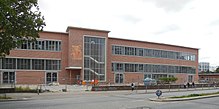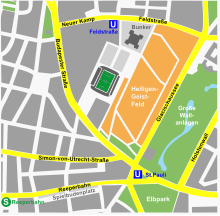Heiligengeistfeld

The Heiligengeistfeld is an area in the Hamburg district of St. Pauli . In the narrower sense that is usually used, the name refers to a 20 hectare event site on which the Hamburg Cathedral takes place. In a broader sense, areas adjoining it to the north-west up to the New Horse Market are also included; the total size is about 50 hectares.
history

The Heiligengeistfeld takes its name from the " Hospital zum Heiligen Geist ", a monastery hospital in Hamburg, to whose lands the area (at that time pastureland) belonged. The oldest known mention of the name "Heiligengeistfeld" dates from 1497. At that time, the area reached into today's Neustadt , about as far as the Kohlhöfen street. However, the hospital itself is probably older:
"In order to distinguish it from the Hospital for the Holy Spirit, which was founded several centuries earlier for similar purposes, the people probably called it 'the great' and the Ilsabe'n house [built in 1428] 'the lütten hillige Geest'."
With the construction of the city fortifications between 1616 and 1625, the eastern part of this area was lost. For this the hospital was compensated with areas in Hamm and Horn . The remainder - today's Heiligengeistfeld - was used, among other things, as a glacis and drill field.
From the end of the 19th century, the area was increasingly used for entertainment purposes, including panoramas , an artificial ice rink and, from 1893, for the cathedral . The historic flour mill was dismantled between spring and the end of August 1939.
location
The Heiligengeistfeld in the broader sense is the area within the triangle Budapester Strasse - Neuer Kamp / Feldstrasse - Glacischaussee. It is bounded in the east by the large ramparts , in the west by the residential areas of St. Pauli and in the north by the Schanzenviertel and Karolinenviertel . Opposite the northwest corner is the new horse market , on the south corner the Millerntor .
Development
The eastern part of the site is undeveloped and serves as an event area.
For the anti-aircraft artillery of the Air Force in 1942, two were on the western side flak towers built; a larger bunker (battle or G-tower) on Feldstrasse and south of it the smaller guide tower (L-tower) on Eimsbütteler Strasse. This was called Ernst-Thälmann- Strasse from 1946 until it was renamed Budapester Strasse after the Hungarian uprising in 1956 .
The G-turret was equipped with four heavy 12.8 cm twin flak ; the L tower housed the associated fire control and radar equipment (" Würzburg giant "). After the Second World War , the military installations and their artillery were removed and the former battle tower was used by civilian tenants because there was a great lack of housing in the destroyed Hamburg. The Feldstrasse bunker was preserved and, after intensive renovation, is now mainly used by companies in the media and event industry.
From 1950 , after the war, the Northwest German Broadcasting Corporation broadcast its first television test programs from the former lead bunker . Daily broadcasting from the Heiligengeistfeld television studio began on December 25, 1952 and ended in 1953 when the newly built studios at Gazellenkamp were opened in Lokstedt . The "television bunker" was completely demolished in 1973/74 except for parts of the foundation to make room for an exchange for the Federal Post Office . As of 2017, there is an 8-storey building at Budapester Straße 18 after several renovations and partly new buildings, which is used by Deutsche Telekom .
The indoor swimming pool St. Pauli of the Bäderland Hamburg GmbH, the Millerntor Stadium of the FC St. Pauli with several associated sports fields and buildings, a business school and on the northwest corner that built in 1950/51 are located along the Budapester Straße to the west one hectare former Zentralviehmarkthalle formerly the Hamburg slaughterhouse . Between this hall and the bunker there is a petrol station , a recycling yard and the Feldstraße underground station on the U3 line . From the latter, a tunnel leads under the Heiligengeistfeld to the St. Pauli underground station in the south .
Railway tracks from the Hamburg Sternschanze train station via the slaughterhouse to Budapester Strasse allowed fairground showmen and circus companies to travel by train with their equipment until the 1980s .
Events
19th century
- In 1863 the International Agricultural Exhibition took place on the Heiligengeistfeld. It was one of the first exhibitions in which the architect Martin Haller erected permanent structures instead of the previously usual tents .
- 1884: The Hamburg Ice Skating Club from 1881 and the Hamburg-Altona Ice Skating Club 1876 jointly announce the first international competition for speed skating and figure skating on the Heiligengeistfeld. Despite the high admission prices, tens of thousands of spectators are said to have attended the event.
- 1885, January 18: The first speed skating race in Germany with recorded results is held.
- 1887, 17./18. February: First (unofficial) German championship in speed skating on the Heiligengeistfeld.
20th century
- The event site is used three times a year for four weeks each time for the Hamburg Cathedral . Outside of these fixed dates, it is used by traveling circuses or as a parking lot.
- After the Second World War there were considerations to build on this centrally located, large and therefore valuable area. Central institutions such as the seat of government or the parliament of a possible northern state with Hamburg as the capital were discussed. Hamburg's Senate under the mayors Brauer , Nevermann and Weichmann repeatedly refrained from such plans.
- In 1986 the Hamburg boiler occurred here .
21st century
- During the soccer World Cup 2006 the FIFA World Cup Fan Festival Hamburg took place on the Heiligengeistfeld, at which daily up to 105,000 visitors (max. 70,000 during a game) were counted.
- The Heiligengeistfeld was also used to broadcast the games during the 2008 European Football Championship . The project was called "Heimspiel Hamburg" and was sponsored by Kia Motors . Up to 40,000 people watched the games every day.
- A so-called party mile was also held on the Heiligengeistfeld on the occasion of the 2010 soccer World Cup after plans by the Hamburg Senate to hold this event in the Volksparkstadion met with fierce criticism.
- From December 28, 2010 to February 20, 2011, the Musical Cats was performed on the Heiligengeistfeld in Hamburg in a specially built tent with 1,800 seats.

The St. Pauli cattle market hall in Hamburg was built in 1950/51 as a central cattle market hall on the northwest corner of the Heiligengeistfeld. The over one hectare building, which previously belonged to the Hamburg slaughterhouse, is a listed building and has been completely refurbished for a new retail use since 2013 after a temporary interruption in use and the dismantling of the partly ailing fixtures. Since September 18, 2014, the almost 15,000 square meter building complex has been reopened as “Hamburg's first covered weekly market”.
Area renovation 2013–2017
In the years 2013 to 2017 a basic renovation was carried out, which in coordination with the Hamburger Hochbahn, energy suppliers and event management included the following work in several partial measures:
- Renewal of the power supply,
- Renewal of the sluice and surface drainage,
- Creation of traffic routes and event areas,
- Ordnance clearance.
Web links
Individual evidence
- ^ Otto Beneke: Hamburg stories and legends . Perthes-Besser & Mauke, Hamburg, 1854, p. 129.
- ↑ The history of the Heiligengeistfeld. Retrieved May 28, 2020 .
- ↑ Picture of the smaller, "TV bunker" . In: epoche-3.de , (JPG)
- ↑ Picture of both bunkers together on the Heiligengeistfeld ( Memento from December 5, 2010 in the Internet Archive )
- ↑ Baurundschau 1951, the new central livestock market in Hamburg accessed on June 22, 2014.
- ↑ Ulrich Gaßdorf: Heiligengeistfeld is becoming a party mile again . In: Hamburger Abendblatt . January 16, 2010, heading last accessed on January 22, 2010 (content subject to charge).
- ↑ http://www.hotspot-hh.de/index.php?option=com_content&view=article&id=101:das-heiligengeistfeld-wird-zum-schrottplatz&catid=45:news ( Memento from July 28, 2014 in the Internet Archive ) . In: hotspot-hh.de .
- ↑ Rindermarkthalle St. Pauli will open soon: this is how it will look ( Memento from September 20, 2014 in the Internet Archive ). In: Bar Rossi - magazine for hill culture. March 6, 2014, accessed June 22, 2014.
- ↑ | www.competitionline.com
Coordinates: 53 ° 33 ′ 21 ″ N , 9 ° 58 ′ 17 ″ E




